Читать книгу Asia Past and Present - Peter P. Wan - Страница 75
Premodern Japan to circa 1868
Оглавление| ca. 40,000 BCE | Old Stone Age: Hunting and gathering |
| ca. 14,000–300 BCE | Jomon period begins transition from hunting and gathering to agriculture; the people are likely the Ainu, who have Caucasian features |
| 300 BCE–300 CE | Yayoi people arrive from Korea and conquer the Ainu, bring new advanced methods of agriculture, and utilize bronze and iron. They are seen as the ancestors of the modern Japanese people |
| 4th–7th centuries | Yamato period: Great Kings rule the tribes on the Yamato Plain |
| 538 | Korean King Seong of Baekje introduces Buddhism to Japan |
| 604 | Prince Shotoku (574–622) promulgates the Seventeen‐Article Charter to officially adopt Confucianism and Buddhism; sends first mission to Tang Dynasty China |
| 646 | Taika Reform of Emperor Kotoku (596–654) introduces institutional reforms to transform Japan into a centralized state under the emperor, based on the Chinese model |
| 7th century | Traditional Japanese state is formed on the Yamato Plain, the title “emperor” replaces “king,” and gradually the government and culture of the Yamato people spread across Japan |
| 710–794 | Nara period reflects Japanese borrowing from China, including the capital Nara, which was based on China’s then‐capital Chang’an |
| 754 | Chinese Buddhist monk Jianzhen (Gajin) arrives in Japan |
| 794–1185 | Heian period finds the emperor’s role in government usurped by the Fujiwara family, which marries into the imperial family and controls it |
| 839 | Last envoy to Tang China |
| ca. 1010 | Fujiwara court life told in the novel The Tale of Genji |
| 12th–16th centuries | Age of the Shoguns: Emperors reign, Shoguns rule |
| 1185–1333 | Kamakura Shogunate, where the Shogun rules over a feudal political and social order, although the Hojo family does marry into the Shogunate after 1203 and controls it |
| 1274, 1281 | Mongol invasions turned back by kamikaze, or “divine wind” |
| 1336–1573 | Ashikaga Shogunate troubled by the emergence of northern and southern imperial courts and the arrival of the Europeans, and with them the beginning of Nanban Trade |
| 14th century | During the Ashikaga period, the peasant foot soldier begins to displace the elite mounted samurai |
| 1467–1603 | Warring States period when Oda Nobunaga, Toyotomi Hideyoshi, and Tokugawa Ieyasu struggle to unify Japan |
| 1603–1868 | Tokugawa Shogunate unifies Japan, creates a centralized feudal society, closes the country to foreign contact, and lays the foundation for modernization from its capital at Edo (today’s Tokyo) |
| 1853–1854 | Americans end the seclusion of Japan and sign a treaty with the Shogunate, which begins a rebellion against the Tokugawa |
| 1868 | The Meiji Restoration ends the Tokugawa rule and the feudal system, and launches a rapid, successful modernization program |
By 300 BCE, the Yayoi people had migrated from the Korean Peninsula to the Japanese islands and conquered the Jomon people. They would become the ancestors of the modern Japanese people. They were like the Koreans in that they had originated in Siberia and Manchuria and migrated to Korea; but unlike the Koreans, they had kept going until they landed in Japan. They spoke an Altaic language related to Korean, but not to Chinese. The Yayoi culture emerged on the Japanese islands with amazing suddenness. They brought with them an advanced New Stone Age agriculture, and employed bronze and iron. These technologies had originated in China, spread to Korea, and now settled in Japan. They built huge earthen mounds over the tombs of their prominent men, which was a typical Korean practice. They were still essentially the same as the Koreans, but had absorbed some of the indigenous Ainu population through intermarriage, and driven the rest northward. In modern times, the Ainu people have lived a relatively primitive way of life on reservations on the northernmost island of Hokkaido, and are suffering from a shrinking population.
